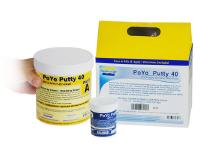PoYo™ Putty 40 /0,97 kg
PoYo™ Putty 40 is a two-component mold making silicones (tin catalyst) that can be mixed and applied “on site” – directly to almost any model. PoYo™ Putty will hold any vertical surface and capture even the finest detail - perfect for making strong rubber molds that can be used within minutes.
PoYo™ Putty has been used to make molds of valuable antiques and archeological models and can be used to make fast molds of sculpture, prototypes, candles, picture frames, coins, etc. You can cast wax, gypsum and a variety of resins into PoYo™ Putty molds.
FEATURES
- Use Less – Do More: Because PoYo™ is applied as a thin layer, less material is used, saving you money. Molds are also lightweight, making them easier to handle.
- Pot life and cure time can be adjusted (faster or slower) by varying the amount of Part B catalyst.
- User Friendly - PoYo™ Putty can be measured and mixed by volume (no scale necessary).
- It will stick to itself and other silicone rubbers, giving the user many application options or for using as a silicone rubber repair
|
|
Instructions
Because no two applications are quite the same, a small test application to determine suitability for your project is recommended if performance of this material is in question.
Safety - Use in a properly ventilated area (“room size” ventilation). Wear safety glasses, long sleeves and rubber gloves to minimize contamination risk. Wear vinyl gloves only. Latex gloves will inhibit the cure of the rubber.
Store and use material at room temperature 23°C. Warmer temperatures will drastically reduce working time and cure time. Storing material at warmer temperatures will also reduce the usable shelf life of unused material. These products have a limited shelf life and should be used as soon as possible.
Applying A Sealer - PoYo™ Putty silicone rubber may be inhibited by sulfur-based clays resulting in tackiness at the pattern interface. If compatibility between the rubber and the surface is a concern, a small-scale test is recommended. Apply a small amount of rubber onto a non-critical area of the pattern. Inhibition has occurred if the rubber is gummy or uncured after the recommended cure time has passed. To prevent inhibition, a “barrier coat” of clear acrylic lacquer sprayed directly onto the pattern is usually effective. Wear Gloves - This product is mixed by hand and wearing gloves is required. Wear vinyl gloves. Latex gloves will inhibit the cure of the rubber.
Applying A Release Agent - Although not usually necessary, a release agent will make demolding easier when casting into most surfaces. Ease Release™ 200 is a proven release agent for releasing silicone from silicone or other surfaces. Mann Ease Release™ products are available from Form X. IMPORTANT: To ensure thorough coverage, lightly brush the release agent with a soft brush over all surfaces of the mold or model. Follow with a light mist coating and let the release agent dry for 30 minutes.
Measuring - Materials should be stored and used at room temperature 23°C. This product has a limited shelf life and should be used as soon as possible. Wear safety glasses, long sleeves and rubber gloves to minimize contamination risk.
Hint: Pre-kneading Part A (working in your hands for one minute prior to mixing with Part B) will make the two components easier to mix.
Measuring By Weight: Using an accurate gram scale, weight out 100 parts A – level by hand into bottom of container. Squeeze 6 parts B into center of flattened Part A. Follow mixing directions below.
Measuring By Volume: The by volume mix ratio is about 20A:1B. Visual Approach: Measure an amount of Part A approximately equal to the size of a golf ball onto the palm of your hand and create an indentation. Squeeze an amount of Part B approximately equal to the size of a small marble into the center of the Part A indentation. (Hint: It is better to start out with less Part B and add more if needed, rather than too much Part B).
Mixing - Fold the Part A around the Part B and knead aggressively with thumb and forefinger. Continue folding until a uniform light-pink color is attained. Make sure that all color streaks have been eliminated.
Applying the Rubber - PoYo™ can be applied directly onto almost any model surface (see preparation above) except skin. After mixing Parts A & B as directed above, flatten mixture and gently press into model detail. Spread evenly over model surface, maintaining about a 1 cm thickness. Mix and apply more as needed, connecting and smoothing seams of different batches together.
Be Careful -If your original is made of modeling clay or other soft material, pressing putty onto model surface may affect model detail. You may want to first apply a thin “print coat” using Mold Max™ silicone and back up using PoYo™ Putty.
Curing & Performance - Allow the mold to cure 30 minutes at room temperature 23°C before removing from model surface. Adding more Part B can reduce cure time. Adding less Part B will give you a longer working time and lengthen demold time. If applying a support shell, apply the shell before removing the rubber mold from the model.
Applying A Support Shell - Usually, PoYo™ Putty molds will be too thin to support themselves during casting. A support shell made of Plasti-Paste™ or Matrix NEO™ and chopped fiber can be applied over the mold surface.
Using The Mold - When first made, silicone rubber molds exhibit natural release characteristics. Depending on what is being cast into the mold, mold lubricity may be depleted over time and parts will begin to stick.
